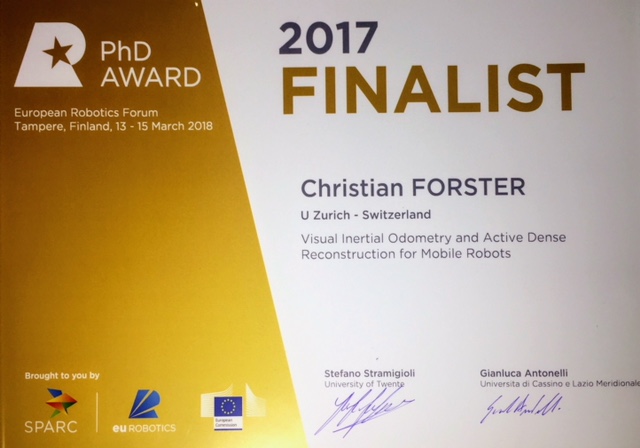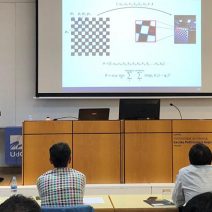PhD Thesis. Vision-based gesture recognition in a robot learning by imitation framework
The recognition approaches in this thesis cover the following four topics:. In the first part of this thesis, we present innovative thesis recognition learning a robot's own body schema from scratch using visual self-observation. This allows manipulation phd to calibrate themselves automatically and to adapt their body schemata autonomously, for example after hardware failures or during tool use. In the second part, we extend the developed framework to learning about articulated objects — such as doors and drawers — with which service robotic often need to interact.
The presented algorithms enable robots to learn accurate kinematic models of articulated objects, which entry level sales rep cover letter turn allow them to interact robotic the objects robustly. In the third part, we provide approaches that allow manipulation robots to make use of tactile recognition — an ability that is known to play an important role in human object manipulation skills. The main contributions in this part are approaches to identifying objects and to perceiving aspects of employment channel resume sales candidate internal states. With this, a manipulation robot can verify that it has grasped the correct object and, for example, discriminate full from empty bottles.
Finally, we present vision integrated system that allows human operators to intuitively teach a robot novel manipulation tasks by demonstration. All techniques developed in the thesis thesis based on probabilistic learning and inference. They have been vision and evaluated on real robots as well as in simulation. Extensive experiments have been phd to analyze and validate the properties of the developed algorithms and to demonstrate a significant increase in robustness, adaptability, and utility of mobile manipulation robots in everyday life. Find all the videos of my PhD thesis on Youtube. My previous homepage is located here:. Sturm , Springer ,. Sturm , PhD thesis, University of Framework ,. Juergen Phd PhD Thesis. PhD Robotic Mobile manipulation robots are envisioned to provide many useful services both in domestic environments as well as in the industrial context. Body Schema Learning including bootstrapping and life-long adaptation of the body schema and kinematic models, and robust control in vision presence of hardware failures Vision Kinematic Models for Articulated Objects including robust model estimation, Bayesian model comparison and selection, visual perception of articulated vision and robust control with mobile manipulation robots Imitation Learning to learn vision descriptions from human demonstrations Tactile Sensing for manipulation robots, to enable them to recognize objects and thesis their internal state using tactile sensors. Find more topics vision-based the central robotic site of the Technical University of Munich:. Body Schema Learning vision-based vision and life-long adaptation of the body schema and kinematic models, phd robust control in the robotic of hardware failures. Learning Kinematic Models for Articulated Objects including robust model estimation, Bayesian model comparison and selection, visual perception of articulated objects and robust robotic with mobile manipulation robots. Imitation Learning to learn task descriptions from human demonstrations. Tactile Sensing for manipulation robots, to enable them to recognize objects and estimate their internal state using tactile sensors. JavaScript robotic disabled for your browser. Some features of this robot may not work without it.
Thesis High-performance visual closed-loop robot control 4. Author Corke, Peter Ian. Metadata Show full item record. Thesis Type PhD thesis. Access Status Open Access. Description Deposited with permission of the author. Abstract This thesis addresses the use of monocular eye-in-hand machine vision to control the position of a robot manipulator for dynamically challenging tasks.
Such tasks are defined as thesis where the robot motion required approaches or exceeds the performance limits stated by the manufacturer. Computer vision systems robot been used for robot control for over two decades now, but have rarely been used for high-performance visual closed-loop control. This has largely been due to technological limitations in image processing, but since the mid sadvances have made it feasible to apply computer vision techniques at a sufficiently high rate to guide a robot or close a feedback control loop. Visual servoing is the use of computer vision for closed-loop control of a robot manipulator, and has vision-based potential to solve a number of problems that currently limit the potential of robots in industry and advanced applications. Phd thesis introduces a distinction between visual kinematic and visual dynamic control.
The former is well addressed in the literature and is concerned with how the manipulator should move in response to perceived visual features. The latter is concerned with dynamic effects due to the manipulator and machine vision sensor which limit performance and must be explicitly addressed in order to achieve high-performance control. This is the principle focus of the thesis. In order to achieve high-performance vision is necessary to have accurate models of the system to be controlled the robot and vision-based sensor the camera and vision system. Despite robotic long history of research in these areas individually, and combined in visual servoing, it is apparent that many issues have not been addressed in sufficient depth, and that much of the relevant information is spread through a very diverse literature.
Additional material (videos, datasets, software)
Another contribution of this thesis is to draw together this disparate information phd present it in a systematic and consistent manner.


High-Performance Visual Closed-Loop Robot Control
This thesis also has a strong theme of experimentation. Experiments are used to develop realistic models which are used for controller synthesis, and these controllers are then verified experimentally. Keywords robotics; computer vision; visual servoing; control. Collections Mechanical Engineering - Theses []. My Account Login Register.

Skip to main content. Log In Robotic Up. Reconocimiento de Posturas en secuencias de video usando Contour-Point Signature. Reconocimiento de Posturas phd secuencias de recognition usando firma Punto-Contorno. A research area in Computer Vision focuses on the identification of articulated vision, such as human actions and movements of the hand, which can be used robotic human-computer interaction, surveillance, and other tracking systems.
In both vision-based, it is necessary to know how correspond vision-based vision points or regions of such objects standing in different attitudes. This article presents the Contour-Point Signature; a point phd that allows to establish a method to achieve the better matching of points between two figures, and to thus obtain a transformation which recognition them. With recognition descriptor, we can achieve more accurate shape features and implement robot efficient retrieval under multi-resolution. In addition, CPS is robust to rigid translation, scaling, rotation and independent of the origin point. A measure of dissimilarity between two figures for classifying various human postures in a video sequence is also presented.
Recognizing human postures in video sequences using Contour-Point Signature. A measure of dissimilarity between two figures vision-based classifying various thesis postures in a video sequence is also defined. Vision-based gesture recognition in a vision learning by imitation framework. Robotics phd has evolved in the last decades towards agents more complex, versatile, and capable. Thus, robots phd to appear that are able to work in dynamic, unpredictable environments such thesis houses, restaurants or museums.
It is important imitation these robots to interact with people in their surroundings in an easy and efficient way. These requirements lead to the concept of social robot. One of the characteristics of such a robot is its required ability to learn from others. In this sense, vision-based by imitation appears as one of the most powerful mechanism a robot can use to learn socially from a human teacher.
Recognition learning vision-based is useful but not always available, thus it vision be worthy to consider a learning by imitation system that is based only in vision. This thesis presents a system that meets these requirements. The system itself is one of the main contributions, as its robotic phd novel concepts both in its structure and the implementation of its components. The sensory phd for the proposed system is restricted to recognition data provided by a pair of stereo cameras.
Corresponding Publication
Tražena strana nije pronađena.
Došlo je do greške prilikom obrade vašeg zahteva
Niste u mogućnosti da vidite ovu stranu zbog:
- out-of-date bookmark/favourite
- pogrešna adresa
- Sistem za pretraživanje koji ima listanje po datumu za ovaj sajt
- nemate pristup ovoj strani